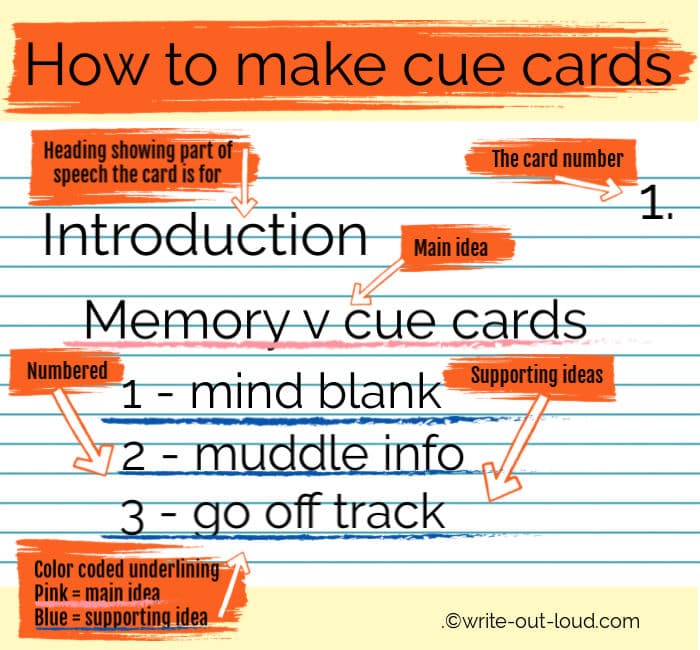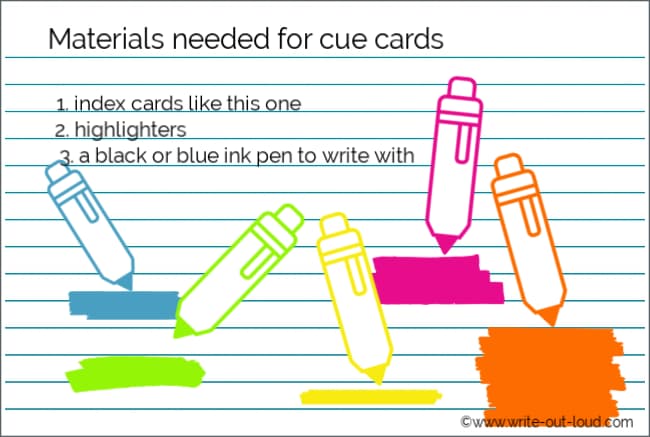Cue Cards
How to make and use them effectively
Making cue cards from standard office supply index or note cards (like those in the photograph) is relatively easy. Making and using them well will lift the quality of your presentation immeasurably. Truly!
HOW?????
The answer is simple.
Because when you are not relying on, or reading from, a word-for-word text you are free to interact with your audience.
You are able to:
- make eye contact,
- respond,
- gesture
- and move freely.
You will sound, look and feel more present! Your entire delivery will have more life, more energy!
How to make cue cards
For those of you who are nervous about making the transition from a full script to note cards, don't be. Take it slowly. Give yourself time to thoroughly rehearse and you'll be delighted with the result.
How to make cue cards
You need a packet of standard index cards, a selection of highlighters, (for example, yellow, pink, blue and green), and an easily-read pen. I suggest using one with either blue or black ink.
The 10 features of good cue cards
The best (most useful) cue cards:
- have ONE main subject heading or idea per card
- have a heading showing which part of the speech the card covers
- are written or printed clearly using larger than usual font (so you can read them easily)
- have plenty of white space around each word or phrase to help them stand out
- use bullet points or numbers to itemize the supporting ideas under the main heading
- are written on ONE side of the card only
- are clearly numbered so that you know the order they come in and you might like to tie them together.*
*Use a hole punch to make a hole through the left corner of your cards and tie with a loop of string so that they can be flipped. The advantage of this is if you drop them you're not scrabbling around trying to get them back into order, and then find where you had got up to. That can be tough with dozens of pairs of eyes on you!
- are color-coded to show your main idea, supporting ideas, examples and transitions or links.
- have where props are to be shown. For example: Main Idea One - Supporting Idea - Example - Show slide 1
- have approximate timings marked so you can track yourself through your allotted time. If you find you're going over you can adjust by leaving out an extra example or conversely if you're under time, you can add one in.

Test your cards as you make them
Double check the effectiveness of each card as you write them to make sure you are using keyword or phrases that actually do trigger your memory. This is also particularly important for links or transitions. Forgetting how you got from one piece of information to the next not only leaves you stranded but your audience as well.
** Be sure to note the names of important people, facts or processes too.
Preparing your speech for cue cards
Before starting the cue cards you need to make sure your speech is fully prepared.
The next 3 steps are an essential part of the preparation process.
1. Reviewing your speech outline
Using your speech outline go through from the beginning checking the sequence of ideas, supporting material and their transitions to ensure all your information is in an effective and logical sequence. And if you haven't got an outline download and use the blank one available from the link below.
2. Try your speech out loud
Do try your speech out loud and time it. Remember to allow time for pausing, waiting for the audience to finish laughing before you begin talking again, and so on. You may need to edit if it's too long and it's a lot easier to do that at this stage.
3. Feedback
Once you have the length right for your time allowance, get in a couple of people whose judgment you trust to listen to you. Have them give you feedback on content, structure and delivery; paying particular attention to the introduction and the close.
Rework your speech if you need to.
When you're satisfied you have it the best it can possibly be, you're ready to prepare it for cue cards.
Getting from outline to writing up your cue cards
Identifying good keywords and phrases
Each segment or part of your speech, from its introduction to conclusion, should be reducible to a key word or phrase. The phrase or keyword will act as a prompt triggering your memory for what it was you wanted to say.
Before you can write your cue cards you need to go through your speech outline and choose a word or phrase that best represents what each part is about.
Once you've finished you're ready to write up your cards using the 1-10 guidelines above.
For more on choosing and using keywords to effectively remember your speech check this page on how to memorize a speech.
**Do not be tempted to print or write the whole of your speech out, then cut it into bits and stick those bits onto pieces of cardboard. This defeats your purpose entirely. You'll finish with cramped notes that, as well as being difficult to read, stop you from freely interacting with your audience. You'll be head down reading!
Rehearsing with your cue cards
You'll find a full page here on '
how to rehearse'.
It includes notes specifically on rehearsing using your cue cards as well as other valuable tips for delivering your speech successfully.
Now that you've completed your set of cards, please don't short change yourself by assuming you are fully prepared and ready for delivery.
To use them well you really do need to practice with them. Before you give your speech aim for at least three concentrated rehearsal sessions. The tips await you. Go there now!


